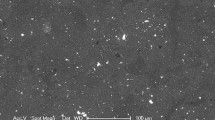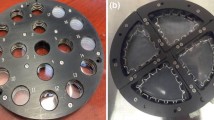Abstract
The objective of this study was to investigate the effect of the photoreactivity of titanium dioxide (TiO2) pigments on the photodegradation of polymeric coatings used in exterior applications. Two polymer matrices, an amine-cured epoxy (EP) and an acrylic urethane (AU), containing three types of TiO2 pigments, classified by different levels of photoreactivity, were studied. Specimens were exposed on an ultraviolet (UV) weathering chamber, the Simulated Photodegradation by High Energy Radiant Exposure device at the National Institute of Standards and Technology. Two exposure conditions were used: ambient, dry condition [25°C and 0% relative humidity (RH)] and high temperature, wet condition (55°C and 75% RH), which is similar to more severe outdoor exposures. The physical and chemical degradations of the filled coatings were monitored at periodic intervals using a combination of laser scanning confocal microscopy (LSCM) and attenuated total reflectance-Fourier transform infrared spectroscopy (ATR-FTIR). Progression of degradation on the coating surfaces was characterized by LSCM in terms of changes in surface roughness and morphology, pigment agglomerate size, and the occurrence of pits or holes in the coatings. The observed physical changes were correlated to the chemical changes measured by ATR-FTIR as a function of UV exposure time. Both EP and AU systems showed less degradation in terms of surface roughness and morphological changes under the dry conditions compared to the wet exposure conditions. It was observed that both the pigment type (and hence photoreactivity) and particle dispersion strongly affected the degradation of both EP and AU systems.















Similar content being viewed by others
References
Fernando, RH, “Nanomaterial Technology Applications in Coatings.” JCT CoatingsTech, 1 (5) 32–38 (2004)
Balfour, JG, “Back to Basics: Durability and Titanium Dioxide Pigments.” JOCCA Surf. Coat. Int., 73 (12) 478–483 (1990)
Gesenhues, U, “Contribution of TiO2 to the Durability of Organic Coatings.” Double Liaison: Physique, Chimie et Economie des Peintures et Adhesifs, X 479–480 (1996)
Simpson, LA, “Influence of Titanium Dioxide Pigment on Durability of Paint Films.” Polym. Paint Color J., 176 (4168) 408–415 (1986)
George, GA, “Weathering of Polymers.” Mater. Forum, 19 145–161 (1995)
Watson, S, Forster, A, Tseng, I, Sung, L, Lucas, J, Forster, A, “Effects of Pigment Type and Dispersion on Photodegradation of Epoxy and Acrylic Urethane Systems.” In: Komarneni, S, Kaneko, K, Parker, JC, O’Brien, P (eds.) Nanophase and Nanocomposite Materials V (Mater. Res. Soc. Symp. Proc., Vol. 1056E, Warrendale, PA, 2008), 05-HH03-67
Siddle, GR, “Titanium Dioxide Pigments.” Paint Technol., 35 (9) 6–11 (1971)
Diebold, MP, Staley, RH, Paints and Coatings Industry, October 1 (2005)
Chin, JW, Byrd, WE, Embree, E, Martin, JW, “Integrating Sphere Source for UV Exposure: A Novel Approach to the Artificial UV Weathering of Coatings, Plastics, and Composites.” In: Martin, JW, Bauer, DR (eds.) ACS Symposium Series 805: Service Life Prediction: Methodology and Metrologies, Chapter 8, pp 144–160. Oxford University Press, Washington, DC (2002)
Martin, JW, Chin, JW, Byrd, WE, Embree, E, Kraft, KM, “An Integrating Sphere-Based Ultraviolet Exposure Chamber Design for the Photodegradation of Polymeric Materials.” Polym. Degrad. Stab., 63 (2) 297–304 (1999)
Corle, TR, Kino, GS, Confocal Scanning Optical Microscopy and Related Imaging Systems, pp. 37–39. Academic Press, San Diego (1996)
Faucheu, J, Sung, L, Martin, JW, Wood, KA, “Relating Gloss Loss to Topographical Features of a PVDF Coating.” J. Coat. Technol. Res., 3 (1) 29–39 (2006)
Allen, NS, Edge, M, Ortega, A, Sandoval, G, Liauw, CM, Verran, J, Stratton, J, McIntyre, RB, “Degradation and Stabilisation of Polymers and Coatings: Nano Versus Pigmentary Titania Particles.” Polym. Degrad. Stab., 85 (3) 927–946 (2004)
Bauer, DR, Dean, MJ, Gerlock, JL, “Comparison of Photostabilization in Acrylic/Urethane and Acrylic/Melamine Coatings Containing Hindered Amines and Ultraviolet Absorbers.” Ind. Eng. Chem. Res., 27 (1) 65–70 (1988)
Acknowledgments
The authors would like to thank Paul Stutzman of NIST for the SEM images, Justin Lucas and Peter Krommenhoek of California Polytechnic State University for initial LSCM images. Research support for Craig Bouis was provided by the National Science Foundation through the Summer Undergraduate Research Fellowship (SURF) Program at NIST.
Author information
Authors and Affiliations
Corresponding author
Rights and permissions
About this article
Cite this article
Wang, D.L., Watson, S.S., Sung, LP. et al. Effect of TiO2 pigment type on the UV degradation of filled coatings. J Coat Technol Res 8, 19–33 (2011). https://doi.org/10.1007/s11998-009-9216-y
Published:
Issue Date:
DOI: https://doi.org/10.1007/s11998-009-9216-y




